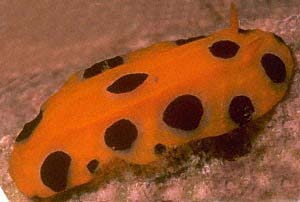
Phyllidia polkadotsa
Brunckhorst, 1993
Order: NUDIBRANCHIA
Suborder: DORIDINA
Family: Phyllidiidae
DISTRIBUTION
Known only from Hawaii.
PHOTO
13 mm specimen, 8 m depth, Makua, Oahu, Hawaii, 8 Feb. 1985, dorsal view, Photo: S. Johnson (Brunckhorst, 1993: Plate 4C).
Notes compiled from Brunckhorst, 1993:
Phyllidia polkadotsa is distinctively patterned. The dorsum is gold with black spots. Ventrally, it is coloured gold. The notal tubercles are low and rounded and there are three low, median longitudinal ridges. The male reproductive organs are elongate compared to other Phyllidia species.
The Mediterranean Phyllidia flava is gold but it has relatively larger tubercles capped in white and it lacks black pigmentation. Phyllidiopsis loricata possesses black spots but has a pale cream to white background colour. Phyllidia polkadotsa does not have any white pigmentation whereas Phyllidia ocellata often has black rings, bordered in white, and with a central gold or white tubercle. Phyllidia ocellata differs particularly from P. polkadotsa in having grey ventral coloration, many more fine lamellae (27-30) on the rhinophoral clavus and the absence of three, low, dorsal longitudinal ridges.
Reference:
• Brunckhorst, D.J. (1993) The systematics and phylogeny of Phyllidiid Nudibranchs (Doridoidea). Records of the Australian Museum, Supplement 16: 1-107.
Rudman, W.B., 1999 (January 12) Phyllidia polkadotsa Brunckhorst, 1993. [In] Sea Slug Forum. Australian Museum, Sydney. Available from http://www.seaslugforum.net/find/phylpolk
Related messages
Phyllidia polkadotsa from Lembeh
November 9, 2009
From: Zeineb Alhaidari
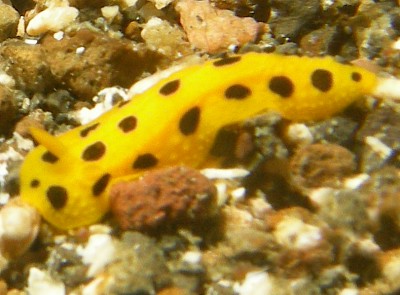
Concerning message #5848:
Hello,
This tiny Phyllidia polkadotsa was noticed due to its bright color on a sandy bottom.
Locality: Dive site : Nudi Falls , Lembeh strait, 10 metres, North Sulawesi , Indonesia, Molucca sea, 09 October 2009, Sandy bottom with scattered reefs. Length: 8 mm. Photographer: Zeineb Alhaidari.
If you think it could be of interest for the forum,
Sincerely,
Zeineb
z.alhaidari@wanadoo.fr
Alhaidari , Z., 2009 (Nov 9) Phyllidia polkadotsa from Lembeh. [Message in] Sea Slug Forum. Australian Museum, Sydney. Available from http://www.seaslugforum.net/find/22760Dear Zeineb,
Thanks for another record of this yellow species, or group of species, with large black spots. As I mention in another message, I am not sure if all the animals I am tentatively placing with P. polkadotsa are the same species. Only time, and more records and more studies, will solve the problem
Best wishes,
Bill Rudman
Phyllidia polkadotsa? from Japan
August 1, 2003
From: Kunihiro Takahashi
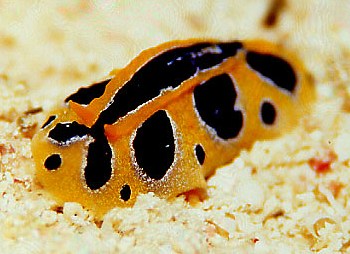
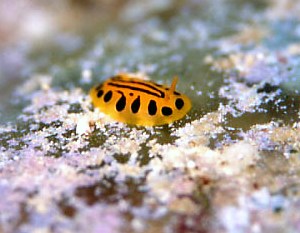
Dear Dr. Rudman,
I found this at Seragaki, Okinawa, Japan.
I think this is Phyllidia polkadotsa.
Could you identify this please?
11 May, 2003
Location: Seragaki Okinawa Japan
Depth: 36m
Length: 35mm
W/Temp: 23C degree
Photo by Kunihiro Takahashi
Best Regards,
Kunihiro Takahashi
manta9216@tontonme.ne.jp
Takahashi, K., 2003 (Aug 1) Phyllidia polkadotsa? from Japan. [Message in] Sea Slug Forum. Australian Museum, Sydney. Available from http://www.seaslugforum.net/find/10011Dear Kunihiro,
Thanks for these interesting photos. I must say I am not sure whether all the animals we now have on the P. polkadotsa page are the same species. However it seems worthwhile keeping them altogether on one page until we have a better understanding of these black-spotted yellow phyllidiids
Best wishes
Bill Rudman
Phyllidia polkadotsa from Phi Phi, Thailand
December 19, 2001
From: Walabha Sinbul
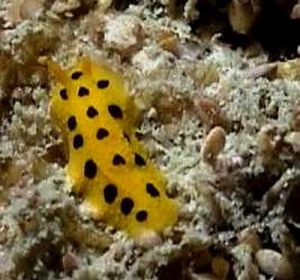
Dear Bill,
Please help me identify this creature. Is it a nudibranch at all, or just a terrific-looking flatworm?
Dive site: Phi Phi island, Thailand
Depth: 16m
Bottom composition: coral rubble
Size: 1cm
Thanks a lot,
Walabha
walabha@yahoo.com
Sinbul, W., 2001 (Dec 19) Phyllidia polkadotsa from Phi Phi, Thailand. [Message in] Sea Slug Forum. Australian Museum, Sydney. Available from http://www.seaslugforum.net/find/5848Dear Walabha,
This is one of the few yellow species of Phyllidia. It is Phyllidia polkadotsa. Formerly only known from Hawaii. Mike Miller [http://siolibrary.ucsd.edu/slugsite/nudwk142.htm ] records it from the Banda Islands of Indonesia and Taiwan, and there are now records on the Forum from Nauru, Vanuatu, possibly the Solomons, and now from Thailand. It is a very interesting discovery.
Best wishes,
Bill Rudman
Phyllidia polkadotsa
June 14, 2000
From: Scott Johnson

Hi Bill,
The first Phyllidia polkadotsa I saw in Hawaii some years ago was brought up in a small shelling dredge from about 100 meters depth. Subsequently, I found a number on shallower reefs, but it is by no means a common species, at least in shallow water. In Hawaii, they live in ledges and caves in coral and lava cliffs. The three photos, h162-1, h162-2, and h162-5, were all taken in Hawaii. There is some variation in the shade of the yellow-orange background color. While I have not yet seen this species here in the Marshall Islands, I found the specimen labelled n002.jpg in Nauru. It was very small and had the look of a juvenile, which is possibly why the zones surrounding the black dots is so white rather than the translucent color seen in the Hawaiian photos. The Nauru specimen does, however, bear the three dorsal ridges, although they are not very distinct.
Interestingly, I went on from Nauru to the Solomons, where I found the specimen labelled s036-1.jpg. This, however, was also small and I think it may be a juvenile Phyllidia ocellata.
Scott Johnson
johnson@kmr.ll.mit.edu


Thanks Scott,
The three ridges seem to be an important character which makes me wonder about its relationship to the black-lined yellow animals Erwin Koehler has sent photos of, which also show these ridges.
I agree with you that the Solomon Ids animal could easily be a juvenile P. ocellata.
Best wishes,
Bill Rudman.
Phyllidia polkadotsa from Vanuatu
November 20, 1999
From: Vinka Stenhouse
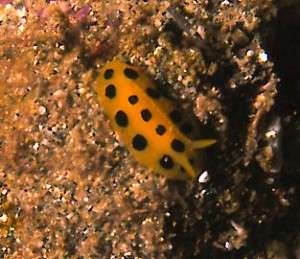
Dear Bill,
I have just got back from Australia where I had a chance to look at the Sea Slug Forum and I must say the photo of Hypselodoris flavomarginata came up very well. I have sent a few other slides that may be of interest and a few I would like to have identified if possible please.
This one is from 17 metre depth in a current prone reef slope, Espiritu Santo Is., Vanuatu, 1998. It was 6mm long.
Yours sincerely,
Vinka Stenhouse.
Santo.
Vanuatu.
Dear Vinka,
This is Phyllidia polkadotsa, which obviously got its name from its colour pattern. By coincidence, I have recently been sent photos of a similarly coloured animal with black stripes rather than spots, from the Maldives.
When it was described in 1993, Phyllidia polkadotsa was only known from Hawaii. I don't know if it is a fairly rare species or whether it is just hard to see or lives in crevices or difficult to see places.
I will put your other photos on the website over the next few weeks.
Best wishes,
Bill Rudman.
